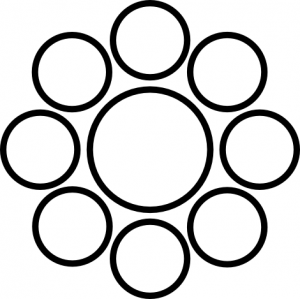Recreational research into Feudal Japan
Archive for April, 2010
On the Origin of Mon
Apr 26th (a Sembu (先負))
So, where did mon come from? While they’re often thought of as being used for battlefield identification, they didn’t start out that way. The first evidence of what became mon dates back to the Heian period (794–1185), when distinctive designs, some of which derive from Nara period (710–794) fabric patterns, were used by the Japanese imperial family and associated court nobility to indicate things like clan membership and religious affiliation.(ja.wp:家紋) One common design from this period is the simple “Shadowed, Nine Stars” design, shown below, used on an imperial ox-cart.(SH:4) “Shadowing” is the Japanese heraldic term for outlining. Note also the standard arrangement of large numbers of circular things, with one larger one in the middle, and the use of relatively large numbers in period mon.
Mon were initially associated with the court nobility and the Imperial family, and were used as decorations on clothing, carriages, and furniture rather than on banners and other stand-alone identification.(ja.wp:家紋) Still, they were a means of identification, and various court nobility families selected distinctive mon. In addition to geometric designs like this one, flowers, birds, and leaf patterns were common.(TM:45) Meanwhile, while warriors used distinctive banners for battlefield identification, these were of a simpler design. The first evidence of mon used for battlefield identification is in the Gempei War at the close of the Heian Period.(SH:10) We’ll look at some of these mon next time.Watch movie online Get Out (2017)
Names and Variation
Apr 5th (a Butsumetsu (仏滅))
Unlike English heraldry, which had an ornate system for describing heraldic devices that became divorced from the normal language, Japanese mon are named using simple phrases using reasonably standard Japanese for the time.1 The mon is named as its primary element, possibly prefixed with modifiers indicating its count, enclosure, style, or other characteristics. In some cases, the enclosure or style may itself has modifiers. Here is an example of a mon used by Inaba Masanari in the late 16th century: 隅切り角に三の字 or “sumi-kiri kaku ni san no ji”, which translates to “in a corner-cut square, the character ‘three’ ”.(SH:54)
These descriptive names lead to two ways mon can differ: they can have different names, or they can have the same name but be drawn differently acheter viagra allemagne. Different members of a family might use minor variations on the family mon, and different families that happened to use the same mon (say, in different provinces) ended up having slight differences due to artistic chance. These minor differences might not be expressed in the simple language of mon names, and would not be great for recognition in the heat of battle, but were in some cases taken seriously as a means of distinction. When a variant became well-known enough, it got its own name of the form “Family Charge”; e.g., the “Aoyama Coins”2, to distinguish it from other identically-named mon. Here are several different bellflower mon: the plain bellflower, two slightly-different but identically-named bellflowers in a circle enclosure, and a ‘shadowed’ or outline bellflower.
This gives you a taste of what common samurai mon might look like. We’ll go into more of the history and possible elements for mon next time.



